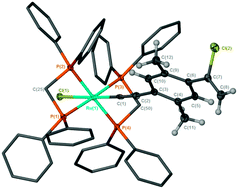Rapid Markovnikov addition of HCl to a pendant alkyne: evidence for a quinoidal cumulene†
Abstract
Reaction of cis-[RuCl2(dppm)2]BF4 with TlBF4 and 1,4-diethynyl-benzenes results in the formation of the vinylidene cations trans-[Ru(![[double bond, length as m-dash]](https://www.rsc.org/images/entities/char_e001.gif) C
C![[double bond, length as m-dash]](https://www.rsc.org/images/entities/char_e001.gif) CH–C6H2-2,5-R2-4-C
CH–C6H2-2,5-R2-4-C![[triple bond, length as m-dash]](https://www.rsc.org/images/entities/char_e002.gif) CH)Cl(dppm)2]+ (R = H, Me). Subsequent reaction with [NnBu4]Cl results in nucleophilic attack at the coordinated organic ligand, but not at the expected metal-bound carbon atom. Instead, trans-[Ru(C
CH)Cl(dppm)2]+ (R = H, Me). Subsequent reaction with [NnBu4]Cl results in nucleophilic attack at the coordinated organic ligand, but not at the expected metal-bound carbon atom. Instead, trans-[Ru(C![[triple bond, length as m-dash]](https://www.rsc.org/images/entities/char_e002.gif) C–C6H2-2,5-R2-4-CCl
C–C6H2-2,5-R2-4-CCl![[double bond, length as m-dash]](https://www.rsc.org/images/entities/char_e001.gif) CH2)Cl(dppm)2] was generated which, when coupled with DFT calculations, provides evidence for an intermediate quinoidal cumulene complex.
CH2)Cl(dppm)2] was generated which, when coupled with DFT calculations, provides evidence for an intermediate quinoidal cumulene complex.


 Please wait while we load your content...
Please wait while we load your content...